The basic strategy here is:
- Create CSS
PseudoClass instances for the conditions you want to highlight (in the example below I created one for "child of selected" and one for "parent of selected")
- Use a
rowFactory to create rows for the table. The rows should update their pseudoclass state in the updateItem method, and should also update their pseudoclass state if the selected items change. You can place a listener on the table's selected items to do the second of these.
- Add CSS in the external CSS file to style the rows the way you want, using the pseudoclasses you defined in the first step.
Here is a SSCCE:
import java.util.ArrayList;
import java.util.List;
import java.util.Random;
import java.util.function.Function;
import javafx.application.Application;
import javafx.beans.property.IntegerProperty;
import javafx.beans.property.SimpleIntegerProperty;
import javafx.beans.property.SimpleStringProperty;
import javafx.beans.property.StringProperty;
import javafx.beans.value.ObservableValue;
import javafx.collections.ListChangeListener.Change;
import javafx.css.PseudoClass;
import javafx.scene.Scene;
import javafx.scene.control.TreeItem;
import javafx.scene.control.TreeTableColumn;
import javafx.scene.control.TreeTableRow;
import javafx.scene.control.TreeTableView;
import javafx.stage.Stage;
public class TreeTableViewHighlightSelectedPath extends Application {
private PseudoClass childOfSelected = PseudoClass.getPseudoClass("child-of-selected");
private PseudoClass parentOfSelected = PseudoClass.getPseudoClass("parent-of-selected");
@Override
public void start(Stage primaryStage) {
TreeTableView<Item> table = new TreeTableView<>(createRandomTree(50));
table.setRowFactory(ttv -> {
TreeTableRow<Item> row = new TreeTableRow<Item>() {
@Override
protected void updateItem(Item item, boolean empty) {
super.updateItem(item, empty);
if (empty) {
pseudoClassStateChanged(parentOfSelected, false);
pseudoClassStateChanged(childOfSelected, false);
} else {
updateState(this);
}
}
};
table.getSelectionModel().getSelectedItems().addListener(
(Change<? extends TreeItem<Item>> c) -> updateState(row));
return row ;
});
table.getColumns().add(column("Item", Item::nameProperty));
table.getColumns().add(column("Value", Item::valueProperty));
Scene scene = new Scene(table, 800, 800);
scene.getStylesheets().add("table-row-highlight.css");
primaryStage.setScene(scene);
primaryStage.show();
}
private <T> void updateState(TreeTableRow<T> row) {
TreeTableView<T> table = row.getTreeTableView() ;
TreeItem<T> item = row.getTreeItem();
// if item is selected, just use default "selected" highlight,
// and set "child-of-selected" and "parent-of-selected" to false:
if (item == null || table.getSelectionModel().getSelectedItems().contains(item)) {
row.pseudoClassStateChanged(childOfSelected, false);
row.pseudoClassStateChanged(parentOfSelected, false);
return ;
}
// check to see if item is parent of any selected item:
for (TreeItem<T> selectedItem : table.getSelectionModel().getSelectedItems()) {
for (TreeItem<T> parent = selectedItem.getParent(); parent != null ; parent = parent.getParent()) {
if (parent == item) {
row.pseudoClassStateChanged(parentOfSelected, true);
row.pseudoClassStateChanged(childOfSelected, false);
return ;
}
}
}
// check to see if item is child of any selected item:
for (TreeItem<T> ancestor = item.getParent() ; ancestor != null ; ancestor = ancestor.getParent()) {
if (table.getSelectionModel().getSelectedItems().contains(ancestor)) {
row.pseudoClassStateChanged(childOfSelected, true);
row.pseudoClassStateChanged(parentOfSelected, false);
return ;
}
}
// if we got this far, clear both pseudoclasses:
row.pseudoClassStateChanged(childOfSelected, false);
row.pseudoClassStateChanged(parentOfSelected, false);
}
private <S,T> TreeTableColumn<S,T> column(String title, Function<S, ObservableValue<T>> property) {
TreeTableColumn<S,T> column = new TreeTableColumn<>(title);
column.setCellValueFactory(cellData -> property.apply(cellData.getValue().getValue()));
return column ;
}
private TreeItem<Item> createRandomTree(int numNodes) {
Random rng = new Random();
TreeItem<Item> root = new TreeItem<>(new Item("Item 1", rng.nextInt(1000)));
root.setExpanded(true);
List<TreeItem<Item>> items = new ArrayList<>();
items.add(root);
for (int i = 2 ; i <= numNodes; i++) {
Item item = new Item("Item "+i, rng.nextInt(1000));
TreeItem<Item> treeItem = new TreeItem<>(item);
treeItem.setExpanded(true);
items.get(rng.nextInt(items.size())).getChildren().add(treeItem);
items.add(treeItem);
}
return root ;
}
public static class Item {
private StringProperty name = new SimpleStringProperty();
private IntegerProperty value = new SimpleIntegerProperty();
public Item(String name, int value) {
setName(name);
setValue(value);
}
public final StringProperty nameProperty() {
return this.name;
}
public final java.lang.String getName() {
return this.nameProperty().get();
}
public final void setName(final java.lang.String name) {
this.nameProperty().set(name);
}
public final IntegerProperty valueProperty() {
return this.value;
}
public final int getValue() {
return this.valueProperty().get();
}
public final void setValue(final int value) {
this.valueProperty().set(value);
}
@Override
public String toString() {
return String.format("%s (%d)", getName(), getValue());
}
}
public static void main(String[] args) {
launch(args);
}
}
and the CSS file (table-row-highlight.css):
.tree-table-row-cell:child-of-selected {
-fx-background: green ;
}
.tree-table-row-cell:parent-of-selected {
-fx-background: salmon ;
}
This give the following:

This version highlights all descendant nodes and all ancestor nodes of the selected items in the tree. You can simplify the updateState() method if you only want immediate child and parent rows highlighted.
